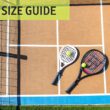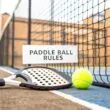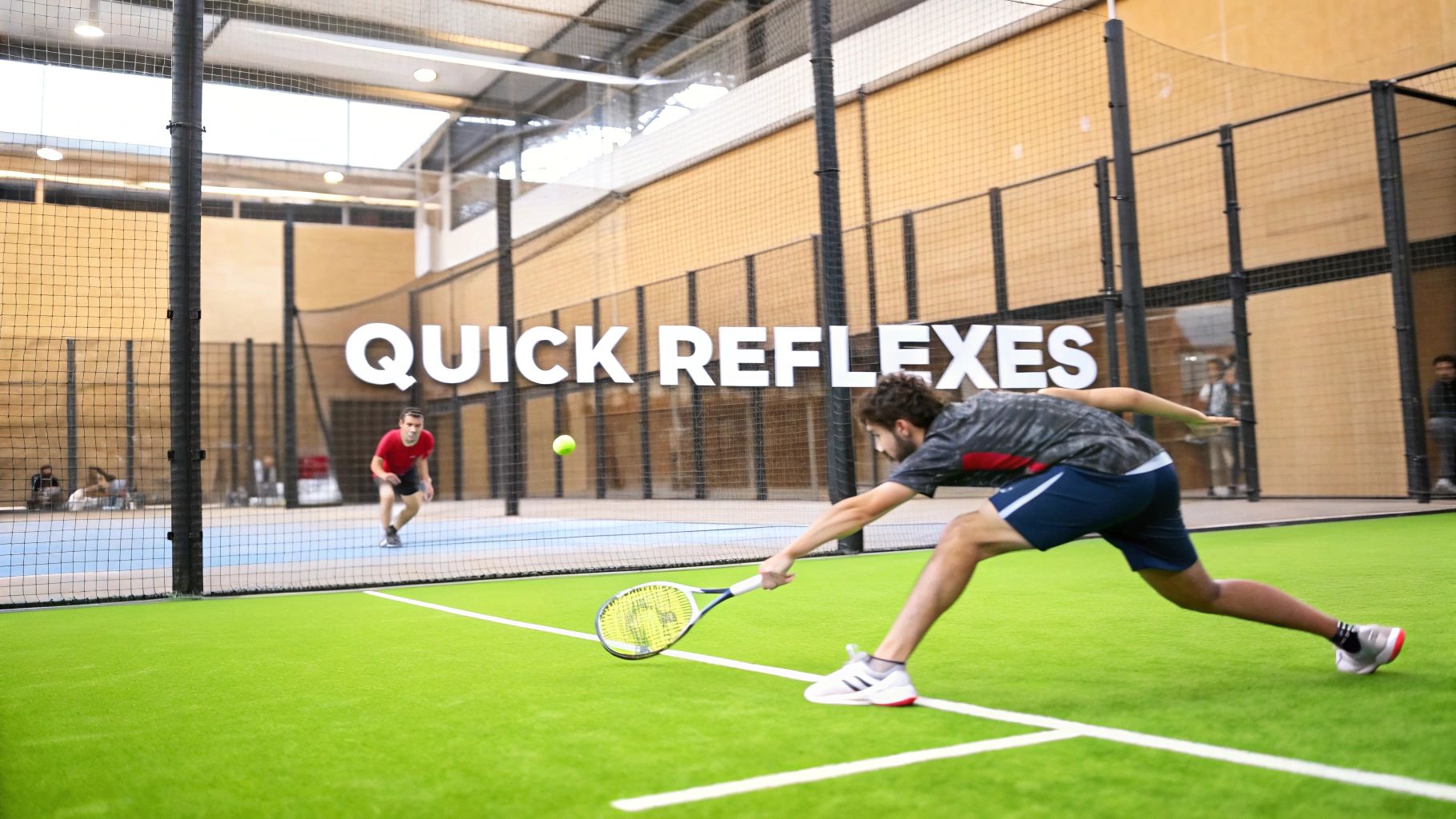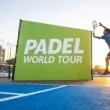In the fast-paced, enclosed world of padel, victory is often decided in a split second. A lightning-fast volley at the net, an instinctive defensive lob against a powerful 'bandeja,' or a quick adjustment to an unpredictable rebound off the glass-these moments separate the good from the great. While many players focus heavily on power and shot technique, mastering the art of the quick response is the true game-changer that unlocks new levels of performance. Improving your reaction time isn't just about moving your feet faster; it's about processing the game more efficiently, anticipating your opponent's next move, and executing the perfect shot before the opportunity vanishes.
This guide moves beyond generic advice to provide a comprehensive collection of actionable drills to improve reaction time on the padel court. We are diving deep into seven highly effective, padel-specific exercises designed to sharpen your cognitive processing and physical reflexes. Whether you are a beginner learning to track the ball or an advanced player looking to dominate the net, these drills will help rewire your brain and body for instantaneous action. You will learn the precise setup, step-by-step execution, and progression for each exercise, giving you a clear roadmap to becoming a more reactive and intuitive player. We'll cover everything from simple ball drops to advanced reactive plyometrics, ensuring there are practical takeaways for every skill level. Forget slow, hesitant movements; let's turn your reactions from a liability into your greatest weapon on the court.
1. The Wall Volley Barrage: Mastering Unpredictable Rebounds
The Wall Volley Barrage is a cornerstone drill for any serious padel player looking to sharpen their net play and drastically cut down their response time. This drill simulates the intense, rapid-fire exchanges that frequently decide points at the net. It forces you to handle a continuous stream of balls with varying speeds, spins, and heights, directly training the core components of reactive ability: visual processing, decision-making, and explosive muscle activation.
At its core, the drill involves one player (the volleyer) positioned near the net and a partner (the feeder) on the other side. The feeder continuously hits balls toward the volleyer, who must return every shot with a controlled volley. The unpredictable nature of the feed is what makes this one of the most effective drills to improve reaction time, as it removes the ability to anticipate and forces pure, reflexive action.

Buy the best padel gear to level up your next game!
CHECK OUT this deal from Padel Market!Get ready to take your game to the next level with the latest padel gear from Padel Market! Fast EU and Worldwide Shipping
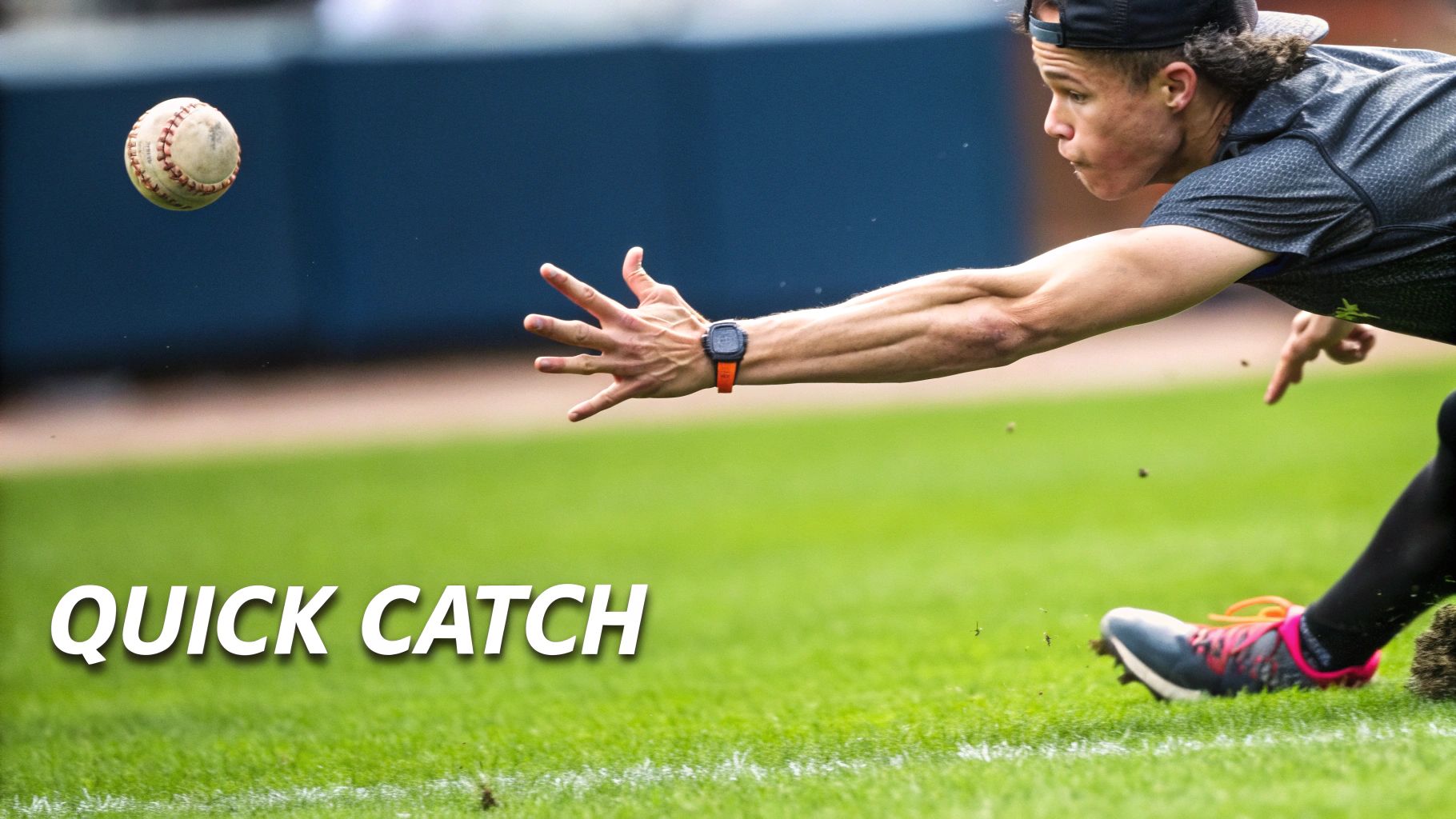
Why It's a Foundational Drill
This drill is a staple in high-performance padel academies across Spain and is frequently used by professional players like Ale Galán during warm-ups. Its value lies in its direct translation to match scenarios. When you're locked in a close-quarters battle at the net, there's no time for elaborate swings or strategic repositioning; success depends on your ability to react instinctively. This drill builds that exact skill set in a controlled yet high-pressure environment.
Key Insight: The goal isn't just to return the ball, but to maintain balance and racket preparation between shots. This "ready state" is what separates good net players from great ones, allowing them to handle the next unexpected shot just as effectively as the last.
How to Implement the Drill
Follow these steps for a successful Wall Volley Barrage session.
Setup and Execution:
- Positioning: The volleyer stands about 1.5 to 2.5 meters (5-8 feet) from the net. The feeder stands on the opposite side, typically around the service line.
- Feeding: The feeder uses a basket of balls to feed a rapid, non-stop sequence directly at the volleyer. The key is variety– mix hard, flat drives with soft, dipping chiquitas and shots aimed at the body, feet, and shoulders.
- The Goal: The volleyer's objective is to block or volley every single ball back over the net. Focus on consistency and control, not power. The aim is to build a "wall" that returns everything.
Actionable Tips for Peak Performance
- Compact Movements: Use a very short backswing. Your volley should be more of a block or a punch, using the opponent's pace.
- Stay Low and Active: Keep your knees bent and weight on the balls of your feet. This athletic stance allows you to make quick lateral and vertical adjustments.
- Racket Up: Maintain a ready position with the racket head up and in front of your body. This reduces the distance the racket has to travel to make contact.
Progressions and Variations
- Beginner: Start with a consistent feed pace to a specific area (e.g., forehand volley) to build rhythm.
- Intermediate: The feeder introduces variations in speed and height, forcing the volleyer to adapt.
- Advanced: The feeder can move side-to-side along the baseline while feeding, changing the angle of attack and making the drill even more dynamic and challenging. This progression is excellent for enhancing your visual tracking and footwork.
2. Light Board Training: Forging Neuromuscular Speed
Light Board Training introduces a high-tech, data-driven approach to enhancing reflexes, moving beyond traditional ball drills into the realm of pure neuromuscular conditioning. This method uses systems of interactive LED light pods or boards, like the popular BlazePod or FitLight Trainer systems, that illuminate in random sequences. The player's task is to deactivate each light by touch as quickly as possible, training the brain to process visual cues and command the body to react with maximum speed and precision.
This system is one of the most versatile drills to improve reaction time because it directly isolates and trains the foundational components of reactive ability: visual stimulus recognition, cognitive processing, and swift physical response. It removes the variables of ball spin or bounce and focuses squarely on shortening the time between seeing a target and physically engaging with it, a skill that translates directly to the fast-paced decisions required on the padel court.
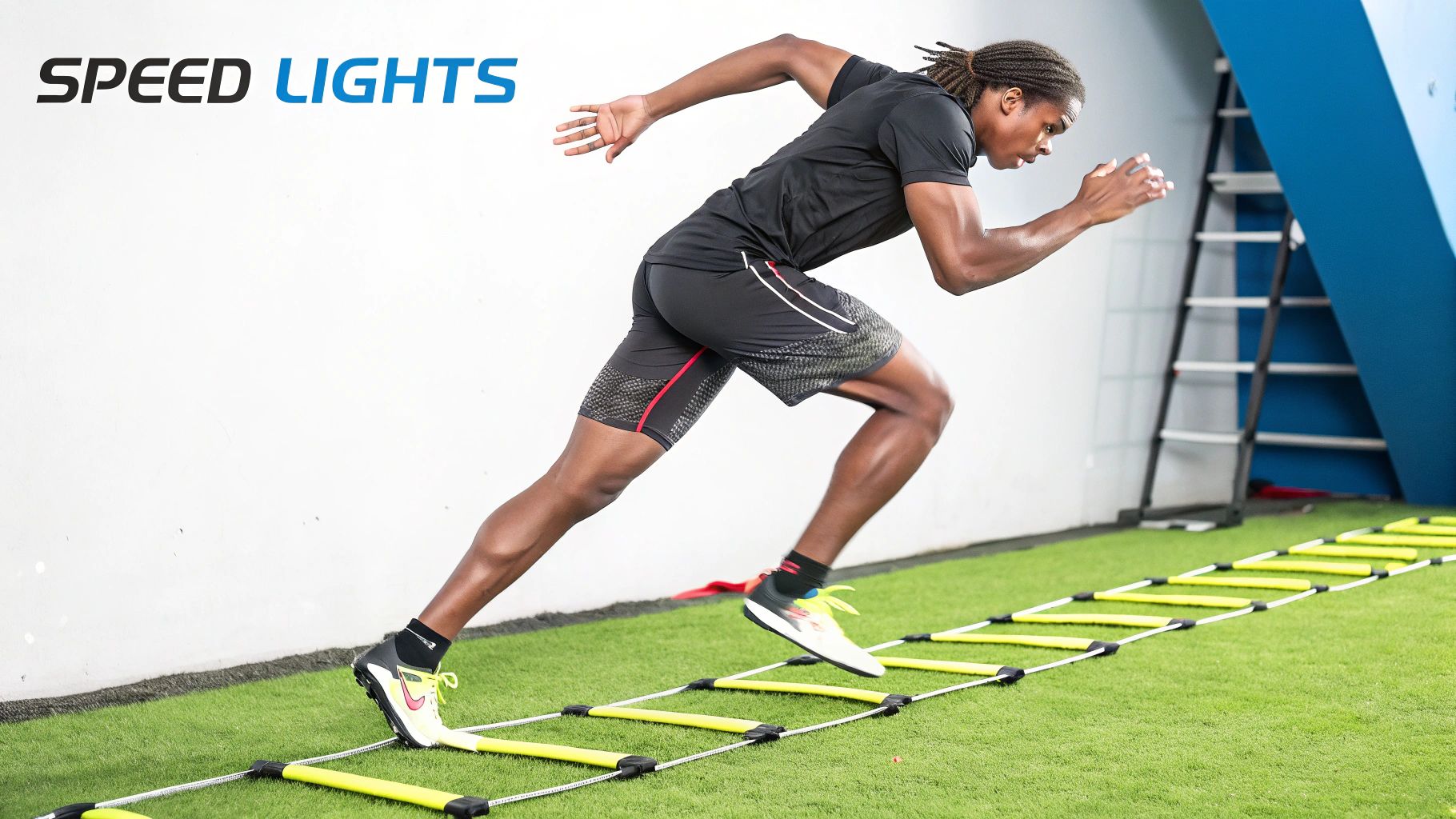
Why It's a Foundational Drill
Adopted by elite performance centers, Olympic training programs, and professional sports teams like those in the NFL and European soccer leagues, light board training provides quantifiable feedback that is impossible to get from standard drills. It measures reaction time down to the millisecond, allowing players to track progress objectively. In padel, this translates to faster responses to smashes, quicker adjustments for a double-glass rebound, and more instinctive volleys during net battles.
Key Insight: The true power of this drill is its ability to train your peripheral vision and decision-making under cognitive load. By forcing you to react to stimuli outside your direct line of sight, it builds the court awareness needed to anticipate and intercept shots you might otherwise not even see coming.
How to Implement the Drill
Follow these steps for a successful light board training session.
Setup and Execution:
- Positioning: Arrange 4 to 6 light pods on the court in a pattern that mimics key padel movements. For instance, place them near the net, at the service line, and by the side and back glass.
- Programming: Set the system to a random light-up sequence. Most systems allow you to control the time between light activations and the duration each light stays on.
- The Goal: The player starts in a ready stance in the center of the pod arrangement. When a light illuminates, they must move to it and tap it with their hand or racket to deactivate it, then immediately return to the central ready position to await the next cue.
Actionable Tips for Peak Performance
- Accuracy Before Speed: Initially, focus on deactivating the correct light cleanly and efficiently. Speed will naturally improve as the movement patterns become ingrained.
- Use Peripheral Vision: Resist the urge to scan the area with your head. Keep your eyes focused forward and use your peripheral vision to detect the lights. This is a crucial skill for tracking the ball, your partner, and your opponents simultaneously.
- Incorporate Padel Movements: Instead of just running, use specific padel footwork. Lunge for low pods, side-shuffle for pods at the net, and perform split-steps upon returning to the center.
Progressions and Variations
- Beginner: Start with a slower sequence and a smaller number of pods placed close together to build basic reaction speed.
- Intermediate: Increase the number of pods and spread them out further. Introduce color-coded challenges, where you only react to a specific color light, forcing cognitive processing.
- Advanced: Combine the lights with a ball feed. A partner feeds a ball immediately after you deactivate a light, forcing you to transition from the reaction drill directly into hitting a padel shot. This master-level drill merges raw reaction speed with sport-specific technical execution.
3. Agility Ladder Reaction Patterns: Fusing Footwork and Cognitive Speed
Agility Ladder Reaction Patterns move beyond simple footwork exercises, creating a dynamic environment where physical speed and mental processing are trained simultaneously. This drill combines the structured movements of an agility ladder with unpredictable external cues, forcing a player to think, decide, and move in a split second. It directly addresses the cognitive link between seeing a stimulus and executing a complex, coordinated physical response, a crucial skill for reacting to sudden dropshots or unexpected lobs in padel.
The core principle is to disrupt pre-planned movement. Instead of just running through a set ladder pattern, you are forced to change your pattern mid-drill based on a signal, such as a verbal command or a visual cue from a partner. This makes it one of the most effective drills to improve reaction time because it trains the brain to process new information under physical duress and immediately translate it into precise footwork.
The following infographic illustrates the fundamental process flow of this reactive drill, showing how an external trigger initiates an instant physical response.
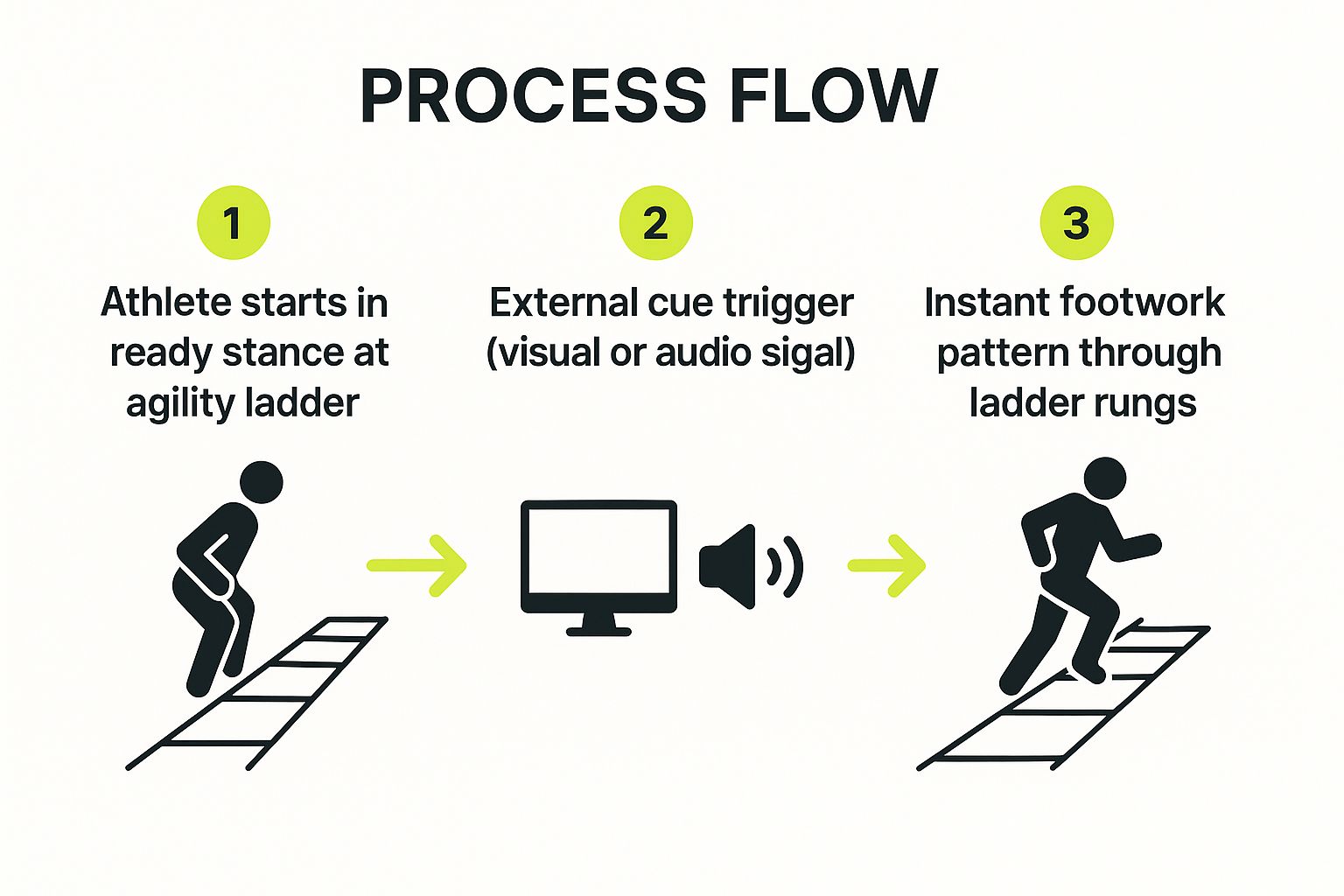

Buy the best padel gear to level up your next game!
CHECK OUT this deal from Padel Market!Get ready to take your game to the next level with the latest padel gear from Padel Market! Fast EU and Worldwide Shipping
This sequence highlights the drill's core challenge: minimizing the delay between the cue and the execution of the correct footwork pattern.
Why It's a Foundational Drill
This method is a staple in elite athletic training across various disciplines, from NFL combine preparation to military fitness programs. Its value for padel lies in developing "reactive agility," the ability to rapidly change direction in response to an opponent's actions. On the court, this translates to faster recovery after a shot, quicker positioning for a defensive glass play, and more explosive movements toward the net. It builds a foundation of coordinated speed that supports every other aspect of your game.
Key Insight: This drill isn't just about moving your feet quickly; it's about training your nervous system to fire the correct motor patterns without conscious thought. The goal is to make your first step in any direction an unconscious, lightning-fast reflex.
How to Implement the Drill
Follow these steps to integrate reactive ladder drills into your training.
Setup and Execution:
- Positioning: Lay an agility ladder flat on the court. You will start at one end in a low, athletic ready stance. Your partner or coach stands a few meters away, ready to provide cues.
- Cue System: Establish a simple set of cues. For example: "One!" means a one-foot-in-each-square pattern, while "Two!" means a two-feet-in-each-square pattern. Or, use visual cues like pointing left or right.
- The Goal: Begin moving through the ladder with a default pattern. On your partner's cue, you must immediately switch to the corresponding pattern without breaking stride or losing balance.
Actionable Tips for Peak Performance
- Master Basics First: Before adding reactive cues, become proficient with several basic ladder patterns (e.g., Ickey Shuffle, in-in-out).
- Keep Eyes Up: Do not look down at your feet. Keep your head up and eyes forward, focused on your partner, to simulate watching an opponent.
- Vary Cue Timing: The feeder should vary the timing of the cues, sometimes giving them early in the ladder, sometimes late, to prevent anticipation.
- Forward and Backward: Practice drills moving both forwards and backward through the ladder to improve your movement in all directions on the court.
Progressions and Variations
- Beginner: Start with two simple patterns and verbal cues. Focus on executing the switch cleanly, even if it's slow.
- Intermediate: Introduce more patterns and use visual cues (hand signals) which require faster visual processing.
- Advanced: Combine ladder drills with a subsequent action. For example, after receiving a cue and finishing the ladder, sprint to a cone and simulate a forehand volley. This links reactive footwork directly to a padel-specific shot. For a deeper dive into similar exercises, learn more about other exercises for reaction time on padelrumors.com.
4. The Mirror Reaction Drill: Syncing Mind and Body
The Mirror Reaction Drill is a dynamic, partner-based exercise that trains the brain's ability to process visual cues and translate them into immediate physical action. Unlike ball-centric drills, this exercise focuses on pure human movement, enhancing full-body coordination, spatial awareness, and the raw speed of your cognitive-motor response. It involves two players: a 'leader' who initiates movements and a 'follower' who must mirror those actions as quickly and precisely as possible.
This drill sharpens the foundational skills needed to read an opponent's body language on the court. By forcing you to react to a person's movements instead of a ball's trajectory, it directly improves your ability to anticipate shots. It’s one of the most versatile drills to improve reaction time because it requires no equipment and can be adapted to target specific padel movements, from split-steps to defensive lunges.
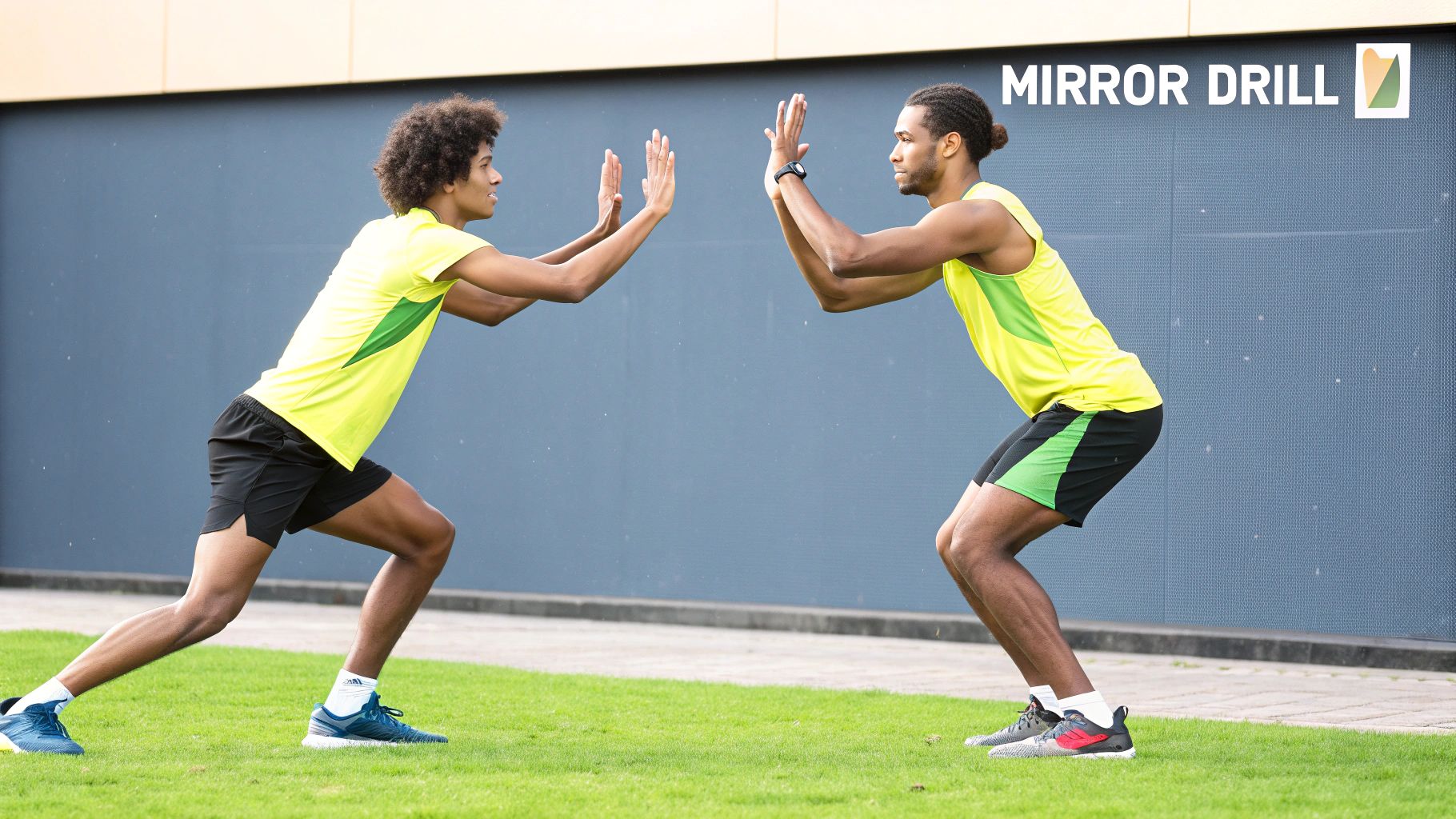
Why It's a Foundational Drill
This type of reactive training is a staple in many elite athletic disciplines, from martial arts where reading an opponent is critical, to basketball where defenders must mirror an attacker's every move. Its value in padel is immense. Anticipating whether an opponent will hit a powerful smash or a soft drop shot often comes down to reading subtle shifts in their body positioning. This drill trains your brain to pick up on those cues and react instinctively, giving you a crucial split-second advantage.
Key Insight: The drill's effectiveness lies in forcing reactive, not predictive, movement. You cannot guess the leader's next action; you can only watch, process, and execute. This breaks the habit of over-anticipating and builds a purer, faster response mechanism.
How to Implement the Drill
Follow these steps for an effective Mirror Reaction Drill session.
Setup and Execution:
- Positioning: Stand facing your partner, about 2-3 meters (6-10 feet) apart. Designate one person as the 'leader' and the other as the 'follower'.
- Movement: The leader performs a series of unpredictable movements. These can include lateral shuffles, forward lunges, split-steps, jumps, or even fake volley/bandeja motions.
- The Goal: The follower's objective is to mirror the leader's actions as if they were a reflection in a mirror. The focus is on minimizing the delay between the leader's movement and the follower's reaction.
Actionable Tips for Peak Performance
- Switch Roles Frequently: Alternate between being the leader and the follower every 30-60 seconds to keep both partners engaged and working on different cognitive skills.
- Focus on the Core: The follower should fix their gaze on the leader's torso or hips. These areas initiate most major movements and are more reliable indicators than the head or arms.
- Quality Over Speed: Initially, prioritize accurate mirroring over speed. As coordination improves, the leader can gradually increase the pace and complexity of the movements.
Progressions and Variations
- Beginner: Start with upper-body movements only (e.g., pointing, shoulder rotations) or simple footwork patterns like side-steps.
- Intermediate: Incorporate padel-specific motions like split-steps followed by a lunge to a forehand or backhand volley position.
- Advanced: The leader can hold a racket and simulate different shots (vibora, smash, chiquita), forcing the follower to react with the appropriate defensive or preparatory footwork. This variation perfectly simulates in-game opponent reading.
5. Audio Response Training: Reacting to What You Hear, Not Just What You See
Audio Response Training bypasses visual cues entirely, forcing an athlete to develop a different, often neglected, reactive pathway. This training method uses sound triggers like whistles, specific words, or app-generated tones to initiate a physical action. In padel, where communication and sound are integral parts of the game (the "pop" of the ball, a partner's call), honing your auditory reactions can give you a significant competitive edge. It trains your brain to process non-visual information and translate it into immediate, precise movement.
This approach conditions your central nervous system to respond without hesitation to auditory signals, a key skill when reacting to a partner's last-second call of "Yours!" or "Out!". It's one of the most direct drills to improve reaction time because it isolates a single sensory input, sharpening your ability to act on sound alone and enhancing your overall court awareness.
Why It's a Foundational Drill
While visual reaction is paramount, the sounds of a padel match provide crucial data. This type of training is used extensively in other sports where auditory cues are critical, from a sprinter launching off the blocks at the sound of a starting gun to a boxer dodging a punch based on the sound of their opponent's exhalation. In padel, it helps you react faster to a partner's instructions or the distinct sound of a mishit shot from an opponent, which might signal an opportunity.
Key Insight: Training with audio cues builds a stronger mind-body connection that isn't dependent on sight. This makes you a more adaptable and instinctive player, especially in chaotic, fast-paced rallies where visual information can be overwhelming or misleading.
How to Implement the Drill
Follow these steps to integrate Audio Response Training into your practice.
Setup and Execution:
- Choose Your Cue: Use a training partner, coach, or a reaction training app to provide audio signals. Cues can be simple (a single clap), varied (different words like "forehand," "backhand," "lob"), or complex (a sequence of tones).
- Define the Action: Assign a specific padel movement to each sound. For example, the word "drive" means you execute a forehand groundstroke shadow swing, while "volley" means you get into a ready volley position.
- The Goal: The player starts in a neutral, ready stance. Upon hearing the audio cue, they must execute the corresponding action as quickly and accurately as possible. The focus is on minimizing the delay between hearing the sound and initiating the movement.
Actionable Tips for Peak Performance
- Combine with Movement: Don't just stand still. Perform the drill while doing light footwork, like split-stepping on the spot, to simulate a real match situation.
- Practice with Eyes Closed: To truly isolate your auditory processing, try performing simple drills (like moving left or right) with your eyes closed. This forces your brain to rely 100% on the sound cue.
- Vary the Cues: Keep your brain guessing. Mix up the timing, volume, and type of audio cue to prevent anticipation and force genuine reaction.
Progressions and Variations
- Beginner: Start with two simple and distinct cues (e.g., a "high" tone for a bandeja and a "low" tone for a volley).
- Intermediate: Introduce more actions and corresponding verbal cues ("chiquita," "bandeja," "vibora"). The feeder can also call out a shot for the player to hit while the ball is in mid-air.
- Advanced: Use a reaction light system with an audio component. The player must respond to a combination of a light and a sound, forcing them to process multiple streams of information simultaneously, mirroring the complexity of a high-level point.
6. Stroop Effect Reaction Training: Sharpening Your Cognitive Edge
Stroop Effect Reaction Training is an advanced, brain-focused drill that moves beyond physical reflexes to target the very core of decision-making speed. This cognitive-physical method introduces conflicting information to force your brain to work harder, process faster, and make the correct choice under pressure. It's a powerful tool for any player looking to reduce hesitation and improve their mental reaction time on the padel court.
The drill is based on the famous psychological phenomenon, the Stroop effect, where it's harder to name the color of a word than it is to read the word itself (e.g., the word "RED" written in blue ink). By integrating this conflict into physical movements, this becomes one of the most innovative drills to improve reaction time, training you to filter out irrelevant information and execute the correct action swiftly.
Why It's a Foundational Drill
This type of cognitive training is a staple in elite performance environments where split-second decisions are critical, from Formula 1 driver training to military special forces programs. On the padel court, it translates directly to situations where you must read a complex play: deciphering an opponent's feint, choosing between a lob or a drive, or reacting to an unexpected shot. This drill trains the brain to cut through the noise and make the right call instantly. This is a core concept within sports psychology, a field dedicated to enhancing athletic performance through mental conditioning. To delve deeper into this, you can explore more about sports psychology techniques on padelrumors.com.
Key Insight: Padel reaction time isn't just about how fast your muscles fire; it's about how quickly your brain processes information and sends the right command. This drill specifically trains that cognitive link, which is often the bottleneck for even physically gifted athletes.
How to Implement the Drill
Follow these steps to integrate Stroop Effect training into your routine.
Setup and Execution:
- Preparation: Use colored cones, cards, or even a smartphone app that displays color words in incongruent ink colors. For a padel-specific setup, place different colored cones in the four corners of the service box.
- The Command: A partner calls out either a word or a color. For example, they might hold up a card with the word "BLUE" written in red ink.
- The Goal: The player must perform an action based on a pre-set rule. For instance, the rule could be "move to the cone matching the ink color, not the written word." In the example above, the player would have to override the impulse to go to the blue cone and instead move to the red one.
Actionable Tips for Peak Performance
- Accuracy First, Then Speed: Initially, focus on making the correct decision every single time, even if it feels slow. Speed will naturally increase as the cognitive pathway becomes stronger.
- Practice When Mentally Fresh: This is a mentally demanding drill. Perform it at the beginning of your training session when your focus is at its peak for the best results.
- Incorporate Padel Strokes: Once you've mastered the movement, add a shadow stroke. For example, moving to the red cone might correspond with a forehand volley shadow swing.
Progressions and Variations
- Beginner: Start with just two colors (e.g., red and blue) and simple commands.
- Intermediate: Introduce four colors and have the partner mix up the rules mid-drill (e.g., "now react to the word, not the color").
- Advanced: The player must perform different strokes based on the stimulus. For example, the ink color dictates the direction (forehand/backhand), while the word dictates the shot type (volley/bandeja). This adds another layer of cognitive load, simulating the complex decision-making of a real match.
7. Reactive Plyometric Jumps: Igniting Explosive Footwork
While many drills focus on hand-eye coordination, Reactive Plyometric Jumps target the foundation of all on-court movement: your feet and legs. This advanced training method builds explosive power and dramatically shortens the time between a visual cue and a powerful physical response. It trains your body to absorb force and immediately redirect it in a new, unpredictable direction, a skill vital for reaching tough shots and recovering for the next volley.
This is more than just standard jumping; it involves making a split-second decision mid-air or upon landing based on an external signal. This process directly links cognitive processing with neuromuscular execution, creating a powerful link that makes your movements more instinctual. For padel players, this is one of the most transferable off-court drills to improve reaction time, simulating the need to suddenly change direction for a surprise bandeja or a drop shot.
Why It's a Foundational Drill
This type of training is a staple for elite athletes in sports like basketball, volleyball, and soccer, where explosive, multi-directional movement is paramount. In padel, the ability to launch powerfully towards the net, retreat quickly for a lob, or spring laterally for a wide shot all depend on the reactive strength built through plyometrics. This drill bridges the gap between raw physical power and intelligent, on-the-fly application.
Key Insight: The true benefit comes from the "cognitive load." By forcing your brain to process a command and execute a new movement pattern under time pressure, you are training your central nervous system to react faster. This mental speed is just as important as physical speed on the court.
How to Implement the Drill
Follow these steps for a safe and effective Reactive Plyometric Jumps session.
Setup and Execution:
- Positioning: Stand in an athletic stance in an open area with safe, non-slip flooring. Have a partner stand in front of you to provide visual or verbal cues. You can also use cones or agility dots as targets.
- The Cue: Your partner will give a signal just before you land from an initial jump. The cue can be a hand signal (pointing left, right, forward, or up) or a verbal command ("Left!", "Stick!").
- The Goal: React to the cue instantly. If the cue is "Left," you land from your first jump and immediately explode into a lateral jump to the left. If the cue is "Stick," you must land and hold the position without any extra hops, focusing on stability.
Actionable Tips for Peak Performance
- Master the Basics First: Before adding reactive cues, ensure you have perfect form on basic jumps like box jumps and broad jumps. Focus on landing softly and with control.
- Prioritize Landing Mechanics: Always land with your knees bent, absorbing the impact through your muscles, not your joints. Your knees should track over your toes, not cave inward.
- Progress Gradually: Start with simple, predictable cues (e.g., always jumping forward). As you improve, your partner can introduce random directional cues to increase the challenge.
Progressions and Variations
- Beginner: Start with a simple "jump and stick" drill. Hop forward and focus on landing and holding your position for three seconds without losing balance.
- Intermediate: Use two cones. Start at a center point, perform a small vertical hop, and have a partner point to a cone. Immediately jump to that cone upon landing.
- Advanced: Incorporate a 180-degree turn. Jump, turn in the air, and upon landing, react to a partner's cue to sprint a short distance in a specific direction. For more ways to build your on-court endurance, check out these stamina training exercises on padelrumors.com.
Reaction Time Drills Comparison Table
| Drill/Training Method | Implementation Complexity 🔄 | Resource Requirements ⚡ | Expected Outcomes 📊 | Ideal Use Cases 💡 | Key Advantages ⭐ |
|---|---|---|---|---|---|
| Ball Drop Reaction Drill | Low – simple setup, requires partner | Minimal – basic ball(s), partner needed | Improves visual processing, hand-eye coordination, reflexes | Rehabilitation, beginner reaction training, accessible drills | Inexpensive, portable, immediate feedback |
| Light Board Training | High – technical setup, digital system required | High – LED boards, maintenance | Enhances multi-directional reaction, precise timing measurement | Professional athlete training, sports performance centers | Precise data tracking, engaging, multi-faceted |
| Agility Ladder Reaction Patterns | Moderate to high – mastering patterns requires effort | Low to Moderate – ladder and cues, space | Boosts cognitive processing under physical stress, footwork | Football, military, advanced sports conditioning | Builds mental & physical skills, sport transferable |
| Mirror Reaction Drill | Low – relies on partner interaction | None – no equipment needed | Develops full-body reaction, anticipation, spatial awareness | Martial arts, dance, basketball defensive skills | Free, sport-specific movement, builds competitive drive |
| Audio Response Training | Low to Moderate – depends on cue complexity | Low – audio device/sources | Trains auditory processing, selective attention | Swimming, military drills, team sports whistle responses | Non-visual reaction skill, simulates game conditions |
| Stroop Effect Reaction Training | High – cognitively demanding | Minimal – requires cue cards or digital tools | Improves cognitive processing under conflict, decision making | High-performance sports, military, esports | Mental toughness, focus, complex scenario transfer |
| Reactive Plyometric Jumps | Moderate to High – requires technique & safety | Low – needs safe landing surface, space | Develops reactive strength, change-of-direction speed | Basketball, volleyball, soccer performance training | Multi-quality athletic development, injury prevention |
Integrating Reactive Power into Your Padel DNA
You have now explored a comprehensive arsenal of drills designed to sharpen your reflexes and slash your response time on the padel court. From the foundational simplicity of the Ball Drop Reaction Drill to the cognitive demands of Stroop Effect Training and the explosive power of Reactive Plyometrics, each exercise targets a unique facet of your reactive ability. The journey from knowing these drills to truly owning them, however, is a matter of consistent, deliberate practice. The true goal is not just to perform these exercises in isolation but to weave their principles into the very fabric of your gameplay, making swift, decisive action your default setting.
From Deliberate Practice to Instinctive Play
Mastering these drills to improve reaction time is about forging new, more efficient neural pathways. Initially, reacting to an unexpected volley or a surprising wall rebound is a conscious, strenuous effort. But with repetition, these actions transition from the conscious mind to the subconscious. Your body begins to recognize patterns and cues without you needing to think about them, freeing up your mental energy to focus on strategy, positioning, and exploiting your opponent's weaknesses.
Think of it this way: a beginner sees the ball, thinks "I need to hit a backhand," and then moves. An advanced player with honed reactions sees the ball and is already moving, their body having processed the trajectory and selected the optimal shot before a conscious thought is fully formed. This is the level of automaticity you are striving for. The drills are the tools to build that instinct.
Key Takeaway: The ultimate aim is to move beyond consciously doing the drills and instead embody the reactive quickness they cultivate. This integration transforms your on-court presence from reactive to proactive.
Building Your Reactive Training Regimen
Consistency will always trump intensity. A marathon, one-off training session will yield far fewer results than short, regular bursts of focused work. To make this actionable, consider implementing a simple, structured approach:
- Pre-Match Activation: Dedicate just 10 minutes before matches to a few key drills. A quick round of the Mirror Drill or some Audio Response Training can prime your nervous system and get you "switched on" for the first point.
- Dedicated Training Blocks: Carve out 20-30 minutes, twice a week, to work through a wider variety of these drills. This is your time to push your limits, track your progress, and experiment with progressions.
- Integrate into Padel Practice: Blend these concepts into your regular hitting sessions. Have your partner feed you unpredictable shots, mixing lobs, volleys, and bandejas without a set pattern to constantly challenge your adaptive responses.
To effectively develop the explosive component of reaction time, it's beneficial to understand the mechanics of athletic conditioning. Exploring various methods, such as these examples of plyometric training, can provide a deeper understanding of exercises that enhance explosive power and quickness, directly complementing the agility you build on the court.
The Ultimate Advantage: Buying Yourself Time
Ultimately, superior reaction time gives you the most valuable and non-renewable commodity in padel: time. It’s the extra fraction of a second that allows you to prepare your shot properly instead of just flailing at the ball. It’s the split-second advantage that lets you turn a desperate defensive scramble near the back glass into a perfectly placed counter-attacking lob.
This newfound time ripples through your entire game. You’ll feel less rushed, make smarter decisions under pressure, and maintain better court positioning. By mastering the moments that happen in the blink of an eye, you gain control over the flow of the rally and, ultimately, the outcome of the match. The drills are your starting point; the court is where you prove the transformation.
Ready to pair your faster reflexes with smarter strategies and the right gear? At Padel Rumors, we provide in-depth guides, professional insights, and equipment reviews to elevate every part of your game. Explore our resources at Padel Rumors and discover how to turn your newfound speed into match-winning dominance.


